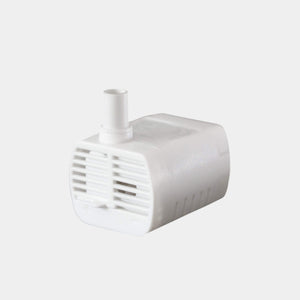Between cuddly toys and climate stimuli – why the children's room is more than just a place to sleep
A child's room is a place full of stories. It's where children dream, play, comfort themselves, laugh—and sleep. But no matter how much we try to lovingly design this space, health considerations often take a back seat in everyday life. Yet the child's room, in particular, is a place that contributes significantly to physical and mental development.
Many parents decorate their rooms carefully, choosing beautiful colors, child-friendly furniture, and soft textiles. But amidst brightly colored plastic toys, synthetic mattresses, and heating without humidity control, an invisible problem can develop unnoticed: poor air quality, harmful substances , and irritants for sensitive respiratory tracts.
Children spend an average of 12 to 16 hours a day in their rooms – toddlers, in particular, sleep significantly longer than adults. Environmental factors have a much greater impact on babies and toddlers, whose immune systems are still developing. So the question isn't "Is it pretty?" but "Is it healthy?"
In this article, we highlight 7 ways parents can make their children's rooms not only beautiful but also healthy – with love, intelligence, and an eye for what is really good for children.
1. Climate that protects: Why a good indoor climate is more than just temperature
There are rooms that immediately feel pleasant – without you being able to put your finger on why. Often, it's the room climate that has a subliminal effect: the combination of temperature, air circulation, and—yes, even—humidity. Especially in a child's room, this delicate balance determines whether a child sleeps peacefully, breathes well, and truly recovers.
What many underestimate is that children have a different perception of heat and humidity than adults. Their respiratory tract is more sensitive, and their mucous membranes are more easily irritated – especially during the heating season, when dry air from heating often pushes humidity below the recommended limit of 40%. Consequences can include dry skin, stuffy noses, nighttime coughing, or even more frequent infections.
The goal isn't to create a tropical climate. Rather, it helps to be conscious of what circulates in the room every day. Ventilation is the simplest solution: ideally, two or three bursts of air per day – even in winter. This is short, intensive, and allows for a flow of air. This not only replenishes oxygen but also removes excess moisture (e.g., after sleeping).
But ventilation alone isn't always enough. Maintaining a consistently balanced indoor climate in homes with central heating, dense insulation, or little natural air circulation can be challenging. A hygrometer—a small device that measures temperature and humidity—is a useful tool. It makes the invisible visible and helps take early action.
And if technical support is necessary, it should be quiet, low-maintenance, and free of chemical additives. Because indoor climate isn't a technical project—it's a daily companion to children's health.
A healthy space is one in which the body and breath can relax – without you noticing. Because the air works with you instead of disturbing you.
2. Quiet please – how noise reduction protects the nervous system
 What many underestimate is that noise is also an environmental factor that has a particularly strong impact on children. Constant exposure to noise—whether from traffic, noisy neighbors, or noisy toys—stresses the nervous system, disrupts concentration, and has been proven to lead to sleep problems.
What many underestimate is that noise is also an environmental factor that has a particularly strong impact on children. Constant exposure to noise—whether from traffic, noisy neighbors, or noisy toys—stresses the nervous system, disrupts concentration, and has been proven to lead to sleep problems.
WHO studies show that even long-term noise exposure above 55 decibels can be associated with increased stress, restlessness and even delays in language development in children.
Tips for more acoustic peace:
- Thick curtains or carpets for sound absorption
- No constant exposure to music or radio plays
- Calm colors instead of sensory overload
- Door seals and felt gliders to prevent rattling furniture
A child's room doesn't have to be a soundproof temple. But it should be a place where silence is possible. Because there's often only a whisper between sensory overload and relaxation.
3. Sleep, my child – how mattress, bed and position make the difference
 Nowhere are children more vulnerable than when they sleep. Yet we often arrange their beds based on practical or aesthetic criteria—but too little consideration of their health.
Nowhere are children more vulnerable than when they sleep. Yet we often arrange their beds based on practical or aesthetic criteria—but too little consideration of their health.
Sleep quality depends largely on the mattress, bed position, and the environment. Beds that are too hard or too soft can put strain on the spine. Synthetic materials promote sweating, provide a home for dust mites, and disrupt thermoregulation. The position of the bed in the room also has an impact: Too close to the heater? Dehydration. Under a window? Drafts.
What matters is a delicate balance between support and flexibility, between freshness and comfort. Ideal mattresses are made of natural latex or coconut, covers made of organic cotton, and a light, breathable bed environment. The environment should be quiet, dark, and free of electrical appliances. Humidifiers or salt devices can also improve the indoor climate – but only if they don't create new sources of irritation, such as noise or chemical additives.
Because good sleep is not just rest – it is the prerequisite for growth, immune system, emotions and development.
4. Small hands, big impact – how children can contribute to a healthy space
 Healthy interior design isn't just a parental project. Children can—and should—be included. Not as an obligation, but as an invitation: to take responsibility, to feel, to participate.
Healthy interior design isn't just a parental project. Children can—and should—be included. Not as an obligation, but as an invitation: to take responsibility, to feel, to participate.
It starts with simple things: opening windows, tending plants, washing stuffed animals regularly. It continues with conscious toy selection: less plastic, more natural materials, bright colors instead of garish sensory overload. And it culminates in the feeling: "This is my space. And I take care of it."
Children who learn early on what fresh air feels like, how pleasant peace and quiet is, and how nice it is to keep things tidy, develop a healthy relationship with their bodies and their surroundings. They intuitively sense what's good for them—and what's not.
The children's room thus becomes a learning space in the best sense of the word. Not for arithmetic and writing, but for self-care, for perception, for responsibility.
And sometimes a little nudge is enough for children to start taking care of their own well-being. A little order here, a little fresh air there – and in the evening, that good feeling: "Here I am safe. Here I can breathe."
5. The power of light – why light sources influence more than just the sense of sight
Natural light sets the pace of our lives – and this is especially true for children. Their internal clock, their mood, and even their growth are all influenced by light. Too little daylight can not only promote fatigue and concentration problems, but also impair vision development in the long term. Studies show that children who spend at least two hours a day in natural daylight have a lower risk of myopia.
In children's rooms, the right lighting also plays a key role in the evening. Blue light from tablets, televisions, or LED lamps disrupts melatonin production—the sleep hormone that prepares the body for rest. Warm, dim light, on the other hand, signals: The day is over. The body can relax.
Ideal solutions:
- During the day: Plenty of daylight through windows, light wall colors, reflective surfaces
- In the evening: Warm white light below 3000 Kelvin, ideally dimmable
- At night: Dim night lights without flickering or blue light
The children's room thus becomes a protective zone against constant digital light – and a stage for the gentle transitions between being awake and dreaming.
6. Less is more – how order, clarity and reduction relieve the nervous system
A cluttered room with piles of toys, flickering lights, and a constant rotation of junk is everyday life for many children. Yet they often need the opposite: clarity, order, and calm. Not as a constraint, but as a structure in which they can feel safe.
Neuroscience shows: Order on the outside creates order on the inside. Stimuli are processed better, children feel less overwhelmed, and can engage in more focused activities – which ultimately leads to greater inner peace. Fewer toys don't mean less joy, but rather more depth. More time for imagination, more focus on one thing, more mindfulness.
How parents can encourage this:
- Clearly structure play areas (e.g. reading corner, craft table)
- Rotate or clean out toys regularly
- Storage systems that children can use independently
- Cleaning up together – not as a duty, but as a ritual
A minimalist yet lovingly designed children's room isn't an empty space. It's a space full of possibilities – for growth, breathing, and self-discovery.
Conclusion: A space that grows with you – and empathizes
A healthy children's room isn't a perfect showroom. It's a space that breathes. That changes. That takes into account the needs of a little person who grows, learns, and reinvents themselves every day.
It's not about renunciation, but about focus. Not about rules, but about a deep understanding: How does this space affect my child? How can I design it so that it not only provides security but also vitality? So that it not only functions but also inspires?
Anyone who embarks on this path will quickly realize: The health of the room is closely linked to the health of the child. Air, light, materials, sound – all of these things work together. And when the child's room becomes a truly comfortable place, you've achieved more than just "good furnishings." You've created a silent ally – for better nights, calmer days, and a strong, healthy upbringing.
Additional note: Support from salty air
Salty air can be a useful addition to everyday life, especially for children with sensitive airways or allergies. Studies demonstrate the beneficial effects of aerosols with high salt content on the respiratory system. For those who can't afford regular trips to the seaside, small, room-sized devices offer a practical alternative.
One example of this is the mini-saline from SalinoVatis. It uses 3D-printed salt structures to create saline indoor air – silently, without filters, and with low power consumption. Without any active intervention, it supports the respiratory system – especially at night, when children are particularly susceptible to external stimuli.
Without claiming to be a cure or therapy, it is not a substitute for medical advice – but it can find its place as a silent player in a healthy child’s room.



